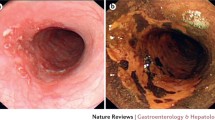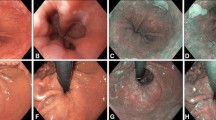Abstract
Background
The larynx and hypopharynx are common sites for head and neck cancer, which shares many risk factors with upper digestive tract disease. Patient survival with malignancies depends on stage at the time of diagnosis. Endoscopic screening of the hypopharynx is neither routinely performed in clinical practice nor has it been evaluated in a formal study.
Methods
This is a prospective pilot study of patients undergoing routine EGD. Demographic data were collected from patients prior to the procedure. All patients in the study underwent an EGD and prior to performing the standard portion of the EGD procedure, the endoscopist evaluated the larynx and hypopharynx with both white light endoscopy (WLE) and narrow band imaging (NBI). Details of the procedure, including ability to see all anatomic structures, time spent, complications, and findings, were recorded.
Results
A total of 111 patients were included in the study. The exam of the laryngopharynx was completed in 87 % of patients (97/111). Reasons for incomplete exam included intubated patients (2/14), inadequate sedation (9/14), and inability to see the entire hypopharynx (3/14). The mean time of the WLE was 20.2 s, while the NBI evaluation took 15.6 s for a mean and 35.8 s for the entire exam of the larynx and hypopharynx. Minor procedural complications occurred in 3/11 (2.7 %) of the patients and included hypotension, tachycardia, and hypoxia. There were 6 patients who had hypopharyngeal abnormalities seen on both WLE and NBI (5.4 %) and were subsequently referred to otolaryngology. Of the six referrals, one patient had a vocal cord biopsy showing leukoplakia, while the others were deemed normal anatomic variants.
Conclusions
Evaluation of the hypopharynx can be accomplished by gastrointestinal endoscopists at the time of EGD in the vast majority of patients in a safe manner while adding only about 35 s to the overall exam time.




Similar content being viewed by others
References
Hoffman HT, Porter K, Karnell LH (2006) Laryngeal cancer in the United States: changes in demographics, patterns of care, and survival. Laryngoscope 116:1–13
Muto M, Minashi K, Yano T (2010) Early detection of superficial squamous cell carcinoma in the head and neck region and esophagus by narrow band imaging: a multicenter randomized controlled trial. J Clin Oncol 28:1566–1572
East JE, Tan EK, Bergman JJ (2008) Meta-analysis: narrow band imaging for lesion characterization in the colon, oesophagus, duodenal ampulla and lung. Aliment Pharmacol Ther 28:854–867
Nonaka S, Saito Y, Oda I (2010) Narrow-band imaging endoscopy with magnification is useful for detecting metachronous superficial pharyngeal cancer in patients with esophageal squamous cell carcinoma. J Gastroenterol Hepatol 25:264–269
Biacabe B, Gleich LL, Laccourreye O, Hartl DM, Bouchoucha M, Brasnu D (1998). Silent gastroesophageal reflux disease in patients with pharyngolaryngeal cancer: further results. Head Neck 20(6):510–514
Emura F, Baron TH, Gralnek IM (2013) The pharynx: examination of an area too often ignored during upper endoscopy. Gastrointest Endosc 78:143–149
Sipe BW, Rex DK, Latinovich D, Overley C, Kinser K, Bratcher L, Kareken D (2002) Propofol versus midazolam/meperidine for outpatient colonoscopy: administration by nurses supervised by endoscopists. Gastrointest Endosc 56(2):324
Zauber AG, Winawer SJ, O’Brien MJ, Lansdorp-Vogelaar I, van Ballegooijen M, Hankey BF, Shi W, Bond JH, Schapiro M, Panish JF, Stewart ET, Waye JD (2012) Colonoscopic polypectomy and long-term prevention of colorectal-cancer deaths. N Engl J Med 366(8):687–696
Magnus MC, Ping M, Shen MM (2011) Effectiveness of mammography screening in reducing breast cancer mortality in women aged 39–49 years: a meta-analysis. J Womens Health 20:845–852
National Lung Screening Trial Research Team, Aberle DR, Adams AM, Berg CD, Black WC, Clapp JD, Fagerstrom RM, Gareen IF, Gatsonis C, Marcus PM, Sicks JD (2011) Reduced lung-cancer mortality with low-dose computed tomographic screening. NEJM 365:395–409
Kujan O, Glenny A, Duxbury J, Thakker N, Sloan P (2005) Evaluation of screening strategies for improving oral cancer mortality: a cochrane systematic review. J Dent Educ 69:255–265
Aitken JF, Youl PH, Janda M, Lowe JB, Ring IT, Elwood M (2006) Increase in skin cancer screening during a community-based randomized intervention trial. Int J Cancer 118:1010–1016
al. HEe (2012) SEER Cancer Statistics Review, 1975–2009
Spector JGea (2001) Delayed regional metastases, distant metastases, and second primary malignancies in squamous cell carcinomas of the larynx and hypopharynx. Laryngoscope 111:1079–1087
Probst R, Grevers G (2006) Basic otorhinolaryngology: a step-by-step learning guide. Thieme, New York
Sieg A, Hachmoeller-Eisenbach U, Eisenbach T (2001) Prospective evaluation of complications in outpatient GI endoscopy: a survey among German gastroenterologists. Gastrointest Endosc 53(6):620–627
Kulapaditharom B, Boonkitticharoen V (2001) Performance characteristics of fluorescence endoscope in detection of head and neck cancers. Ann Otol Rhinol Laryngol 110:45–52
Piazza C, Peretti G (2008) Narrow-band imaging: a new tool for evaluation of head and neck squamous cell carcinomas. Review of the literature. Acta Otorhinolaryngol Ital 28:49–54
Piccirillo JF, Lacy PD, Basu A (2002) Development of a new head and neck cancer-specific comorbidity index. Arch Otolaryngol Head Neck Surg 128:1172–1179
Duchateau CS, Stokkel MP (2005) Second primary tumors involving non-small cell lung cancer: prevalence and its influence on survival. Chest 127:1152–1158
Acknowledgments
None.
Disclosures
Shanlee Stevens, Dr. Johnson, Dr. Pfau, and Dr. Dailey have no conflict of interest or financial ties to disclose.
Funding
No specific funding was used for this study or paper.
Author information
Authors and Affiliations
Corresponding author
Rights and permissions
About this article
Cite this article
Stevens, S.M., Johnson, E.A., Pfau, P.R. et al. Visual evaluation of the larynx and hypopharynx during esophagogastroduodenoscopy: a safety and feasibility study. Surg Endosc 29, 1209–1215 (2015). https://doi.org/10.1007/s00464-014-3796-z
Received:
Accepted:
Published:
Issue Date:
DOI: https://doi.org/10.1007/s00464-014-3796-z




